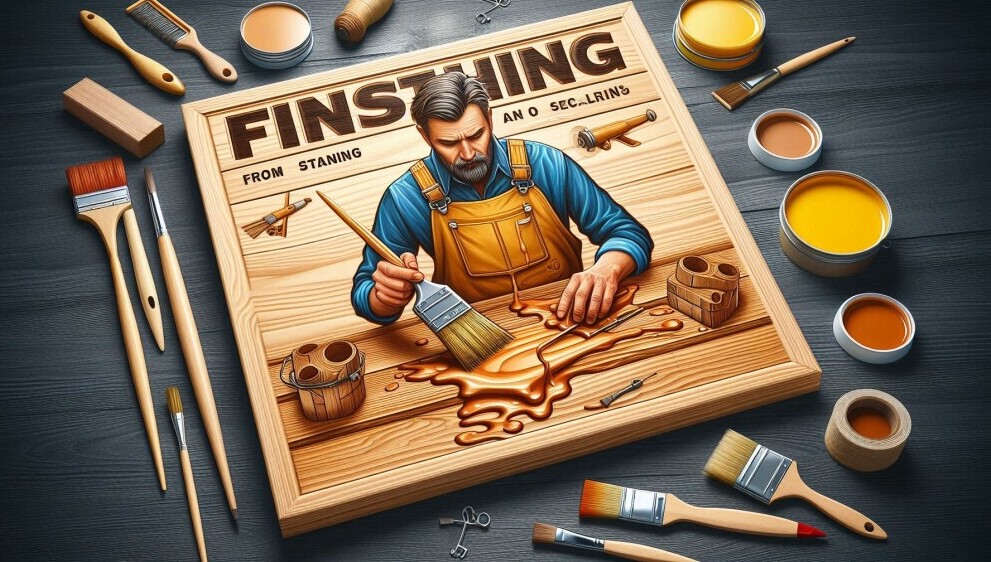You’ve measured twice, cut once, sanded your heart out, and now it’s time for the final touch — the finish. Whether you’re crafting a custom dining table or building a rustic cutting board, a professional finish can make or break your project. But don’t worry. With a little guidance, you can finish wood like a seasoned pro.
Let’s walk through the key stages of wood finishing: prepping, staining, sealing, and protecting — plus a few expert-level tips to elevate your results.
** Here’s a little transparency: Our website contains affiliate links. This means if you click and make a purchase, we may receive a small commission. Don’t worry, there’s no extra cost to you. It’s a simple way you can support our mission to bring you quality content.**
As an Amazon Associate, I earn from qualifying purchases.
Step 1: Surface Prep — The Unsung Hero of Finishing
Before any stain or sealer touches your project, preparation is everything. Sloppy prep work means blotchy finishes, uneven staining, and disappointment.
Here’s how to do it right: Sandpaper…
- Sand progressively using 80-, 120-, and 180-grit sandpaper. If you’re working on softwoods like pine, you might stop at 150 to allow better stain absorption.
- Always sand with the grain to avoid visible scratches.
- After sanding, remove dust with a tack cloth or a vacuum with a brush attachment. Avoid using compressed air — it can force dust deeper into the grain.
Want a smooth – as – glass finish? Give your wood a quick wipe with a damp rag to raise the grain, then lightly sand again once it dries.
Step 2: Staining — Bringing Out the Beauty
Stain enhances the natural character of the wood, bringing depth, warmth, or bold contrast depending on the species and stain color.
Choose the Right Stain:
- Oil – Based Stains: Offer longer working times and deep penetration. Ideal for large projects.
- Water – Based Stains: Dry quickly, have low odor, and are environmentally friendly.
- Gel Stains: Great for vertical surfaces or blotch-prone woods like pine or maple.
Application Tips:
- Use a lint – free cloth, brush, or sponge to apply. Work in manageable sections.
- Let the stain sit for 2 – 5 minutes before wiping off the excess.
- For deeper color, apply a second coat after the first dries fully.
Pro Tip: Test your stain on a scrap piece of the same wood. Colors can look wildly different on cherry vs. oak.
Step 3: Sealing — Lock in the Color
After staining, you need a sealer to lock in the color and prepare the surface for the final topcoat.
Why Seal?
- Prevents the stain from bleeding into your finish coat.
- Smooths out wood grain for a more even protective finish.
Best Sealers for the Job:
- Shellac: Dries fast and gives a warm glow. Great for antique – style finishes.
- Sanding Sealer: Ideal for softwoods. It fills the grain and sands easily.
Apply your sealer in a thin, even coat, then let it dry completely. Sand it lightly with 320 – grit paper before moving on.
Step 4: Topcoat — Protect and Shine
Now that your color is perfect, it’s time to protect it with a durable finish.
Choose Your Topcoat:
- Polyurethane: Tough, water – resistant, and available in gloss, semi-gloss, and satin. Perfect for tabletops and high-traffic pieces.
- Lacquer: Dries fast and builds a beautiful, smooth layer. Great for smaller projects and spray applications.
- Oil Finishes (like tung or Danish oil): Easy to apply and enhance the wood’s natural texture but require more upkeep.
- Water-Based Poly: Crystal clear and fast-drying. Ideal if you want a modern look with low odor.
Application Techniques:
- Use a natural bristle brush for oil – based products and a synthetic brush for water – based finishes.
- Work in thin layers. More thin coats are better than one thick one.
- Lightly sand between coats with 400 – grit paper or a fine synthetic pad.
Allow plenty of drying time between coats — patience is key to a professional look.
Advanced Tips for a Flawless Finish
- Rub it out: For a silky, smooth feel, consider rubbing out the final coat with 0000 steel wool and paste wax.
- Watch your environment: Temperature and humidity can affect drying time. Try to work in a controlled space between 65°F – 75°F.
- Avoid contamination: Keep brushes, rags, and work areas clean. A single stray hair or dust speck can ruin a finish.
Common Wood Finishing Mistakes to Avoid
- Skipping the sanding: No amount of finish will hide poor surface prep.
- Over-applying stain: Let the wood absorb what it wants, then wipe off the rest.
- Not allowing drying time: Rushing can lead to tacky surfaces and cloudiness.
- Using the wrong brush: Always match your brush to your finish type.
Tools & Supplies Checklist
Here’s a quick checklist to keep in your shop:
- Sandpaper (80 to 400 grit)
- Tack cloth
- Brushes (natural and synthetic)
- Stains (gel, oil – based, or water – based)
- Sealers (shellac or sanding sealer)
- Topcoat (polyurethane, lacquer, or oil)
- Stir sticks (don’t shake the can!)
- Rags or sponges
- Disposable gloves
Conclusion: Elevate Your Woodworking With a Professional Finish
A great finish doesn’t just protect your project — it elevates it. Taking the time to prep, stain, seal, and topcoat properly shows craftsmanship, patience, and pride in your work. Whether you’re building heirloom furniture or selling charcuterie boards at a craft fair, a pro – level finish is your signature.
Explore more woodworking finishing techniques in our other helpful guides like Essential Tools Every Woodworker Should Own, or see what sells best in our popular article: Best Selling Wood Projects at Craft Fairs and Online. And when you’re ready to build your next masterpiece, check out our article on Best Dust Collection Solutions For A Small Workshop.
Got a question or want to share your latest project? Drop a comment below or tag us on social media.
We would love to hear from you!



